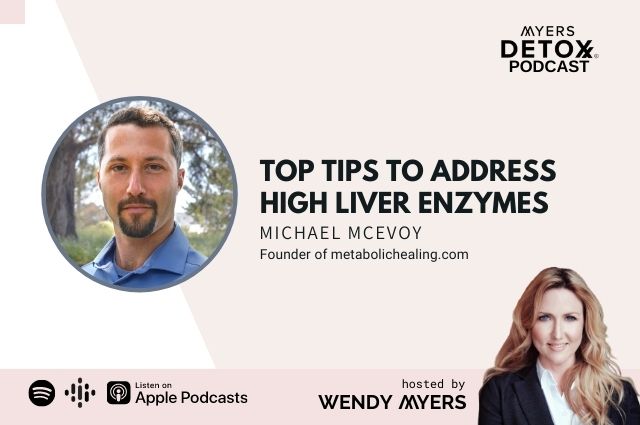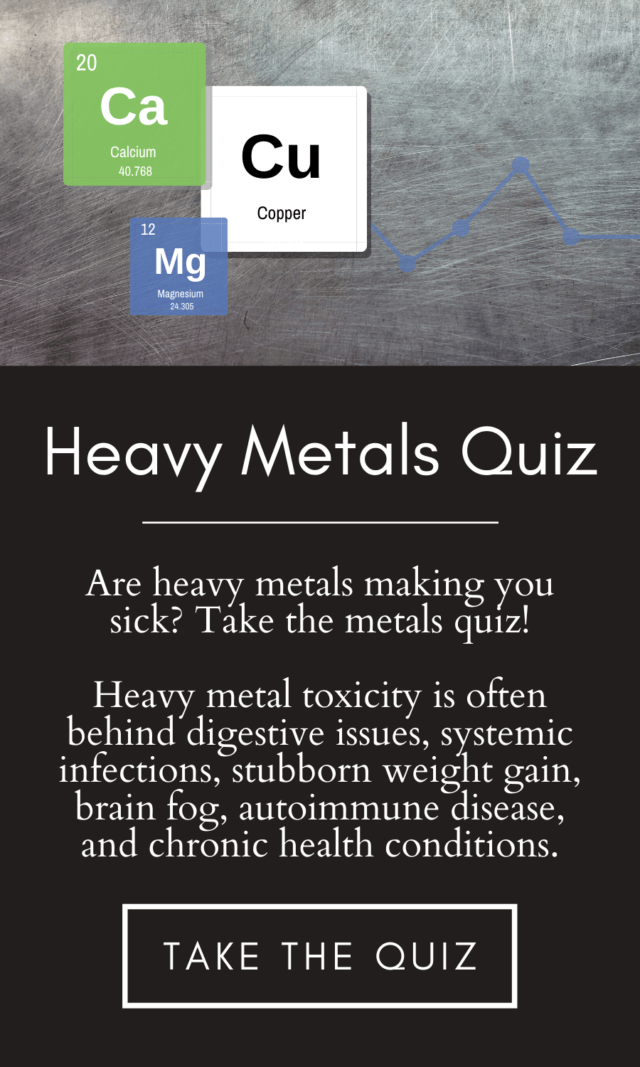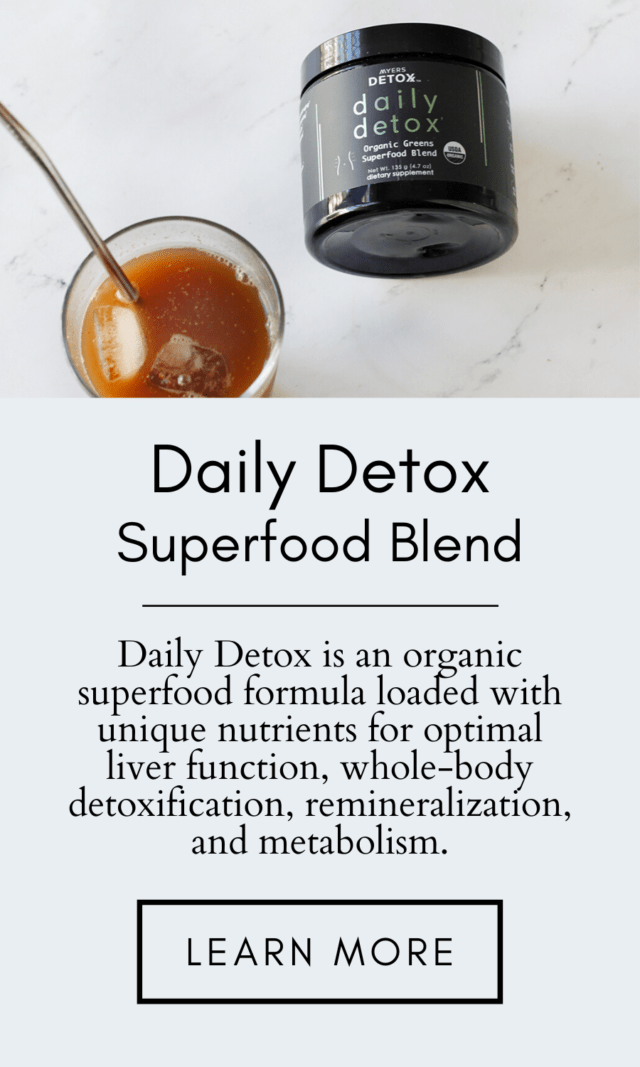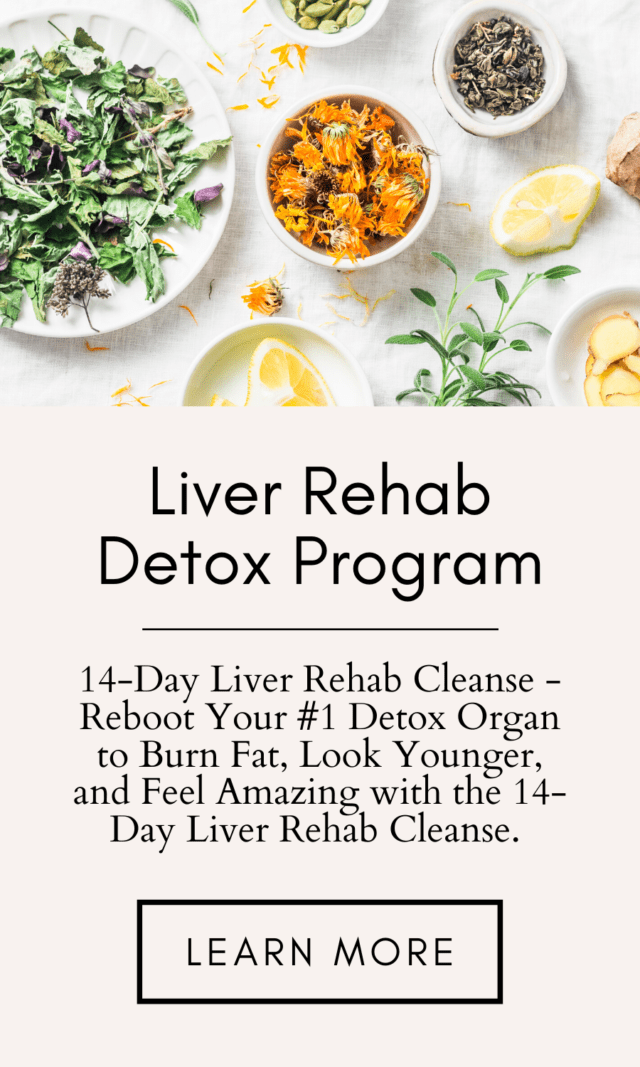Transcript #396 Top Tips to Address High Liver Enzymes with Michael Mcevoy

Listen
Listen to this podcast or watch the video. CLICK HERE
Transcript
Download PDF
Click to jump to a section!
- Michael Mcevoy joins the show to discuss the best tests you can do to find out the health of your liver, how to interpret their markers, and what to do if your markers indicate problem areas. Michael also talks about the essential proteins and liver enzymes that affect the health of your liver, supplements to improve liver function, and his functional blood chemistry analyzer software.
- Find out about some of the common markers you will see on liver tests, including albumin, which is one of the most essential proteins that must be addressed in order to keep your liver functioning optimally.
- Find out vegans should supplement with in order to protect their albumin levels.
- Learn about the other essential protein globulin and what its levels indicate on tests.
- Learn more about the marker bilirubin’s role in detox.
- Find out some of the techniques Michael uses to address high levels of bilirubin.
- Learn about the five liver enzymes, what their levels indicate on tests, and how they relate to liver function.
- Learn about some of the other liver tests Michael recommends and what they can help indicate.
- Learn about some of the limitations of liver tests, and some of the additional tests you can perform that can provide more insight as to the health and functioning of your liver.
- Find out how toxins affect your liver health.
- Learn about Michael’s functional blood chemistry analyzer software, or FBCA, which allows you to input markers from your blood tests, and learn more about what the levels mean and some basic recommendations to help address problem areas.
- You can learn more about Michael and his work at metabolichealing.com
- You can check out the functional blood chemistry analyzer software at www.true.report/
Wendy Myers: Michael, thank you so much for joining us.
Michael McEvoy: Thanks, Wendy, it’s great to be here.
Wendy Myers: Guys, my name is Wendy Myers of myersdetox.com and I wanted to have Michael McEvoy with me, who is one of the practitioners I really, truly respect. I think he’s so brilliant, I highly recommend working with him.
Michael McEvoy: We actually have two websites metabolichealing.com and true.report then the other website is for our software that’s true.report.
Wendy Myers: Okay, fantastic, you have great software which we’ll talk about in a minute, where you can plug in your liver labs. We’re going to talk today about liver enzyme testing. When you go to your medical doctor, ask the doctor to check your liver enzymes. They do this periodically in your routine exam and routine checkups. Sometimes they come back elevated, and I think people don’t have an understanding of what these liver enzyme labs mean. Let’s talk about some of the common conditions that can be revealed on a liver enzyme test, done with a doctor or a functional medical practitioner.
Michael McEvoy: Wendy, there’s actually quite a bit of useful data that you can extract from your standard blood chemistry panel. Over recent years there’s been sort of a flurry of direct-to-consumer lab test companies that enable basically anybody, to order a blood test in the United States. If you start to get good at this, you can start to really understand just how useful basic blood chemistry markers can be when trying to put together some sort of a health program. There’s a whole handful of markers on your metabolic panel blood tests that can reveal useful information about liver function. Not only liver function, but I should also say, the whole function of the hepatobiliary system. The hepatobiliary system encompasses not just the liver, but it could also include the bile ducts, as well as the gallbladder.
Michael McEvoy: As you know, these are the major organs, often referred to as the major organs of detoxification or bio transformation. Your standard blood test does a pretty decent job of providing sort of a basic overview of the hepatobiliary system. What we’re going to talk about today are just some of these useful markers. I’m happy to also provide the sort of reference ranges that I look for when I’m interpreting a blood test.
Wendy Myers: Yeah, talk to us about a few of those markers. When you go to the doctor and you get your lab results, what are the common markers that we see on these lab tests and what do they mean?
Michael McEvoy: The marker that’s the most relevant to me in terms of liver function, and actually one of the most important markers on the blood test, in general is the serum albumin level. The albumin is one of the most, if not the most important blood protein. Why it’s so relevant with the liver is that about 90 to 95% of all the albumin that is circulating in your bloodstream is derived from your liver. Whenever you see the albumin level decreased, it’s a pretty strong indication that the liver is unhappy or the liver is toxic or there’s liver damage or there’s suppressed liver function. I want to talk about some of the basic functions of albumin. Albumin is a very large protein and it transports very important nutrients to the cells and the tissues. You can think of it as sort of a delivery truck. Albumin can transport many of our hormones and that includes our thyroid hormone. Albumin also is going to transport electrolytes in different minerals like calcium, for example.
Michael McEvoy: Albumin consists of a number of different amino acids. It’s actually a very large protein, if you will. One of the types of amino acids that really makes up a major portion of albumin, is an amino acid known as cysteine. Cysteine is a sulfur containing amino acid and the cysteine amino acid is known as thiol. Thiol and sulfur in general are very, very important for the function of the liver. We’ll get into this a little bit later, but know for now that your liver needs some very basic nutrients in order to function. If we kind of break it down, what are the most simple, basic and important nutrients that the liver needs? It turns out that these same nutrients are also needed to synthesize albumin in the liver, which again is the major hepatic liver transport protein. So we’re looking at water, you’ve got to be optimally hydrated. You’ve got to make sure that you’re consuming adequate fluid on a daily basis, not diuretics, like coffee or alcohol, or tea, but actually water. We can get water from vegetables as well.
Michael McEvoy: We also need amino acids and we need protein. There are studies going back to the early 1970s that clearly show that there’s about 12 or 13 amino acids that are really important in order to synthesize more albumin. By eating good quality protein, for example whey protein is a good source of amino acids, or eggs are an excellent source of protein, the amino acids in there will help to synthesize more albumin in the liver. I can give you if you like, some case study examples of what can really go wrong in a serious case where the albumin level is really, really low. The albumin is really one of the most important blood chemistry markers and it’s a major marker that can give us information about liver function. I always want to see on a blood test that the albumin level is between about 4.1 and 4.8. Whenever the albumin level drops under 4, I know that there’s some sort of acute stress or acute inflammation, and it usually indicates that there’s either liver cell damage or what we call diminished liver function.
Michael McEvoy: So, albumin is a huge marker and we can really use basic nutritional practices, the fundamentals of health to really optimize our liver’s production of the albumin. Now, in cases where the albumin levels start to precipitously drop, a 3.5 and even lower, the lower the albumin drops, the more we start to see changes in what’s called the osmotic pressure. Basically what you need to know is that this has to do with the fluid balance between cells and tissues. So, if you don’t make enough albumin, this can be a cause of edema or fluid accumulation. I had a client once with all sorts of colitis and he was nutritionally depleted. His albumin was circling around 2.5. Now, the albumin doesn’t really fluctuate that much, it’s in a very narrow range most of the time. His was extremely low and he developed extraordinary fluid retention in his lower extremities. Because he didn’t know what was causing that, I said, “go get a blood test, I bet anything your albumin level is under three” and sure enough it was.
Michael McEvoy: This can be a very serious condition when the albumin drops this low, so the actual therapy that I recommended was that he increased his intake of red meat to something like one and a half to two pounds of red meat for about five to seven days. Wendy within about seven days, his albumin level restored to normal and the fluid in his lower extremities had cleared. It should really alert you that albumin is a very significant marker not only of liver function, but it plays a really important role in the overall body’s health.
Wendy Myers: If you’re on a vegan diet, how is that going to throw a wrench into your albumin and can being on a vegan diet long term cause low albumin?
Michael McEvoy: We very frequently see that vegan diets don’t contain enough amino acids and it’s primarily the amino acids that you need to synthesize the blood protein albumin. You need adequate sulfur in the form of cysteine and or methionine which can make cysteine. Vegan diets don’t contain any cysteine and they typically lack methionine which is an essential amino acid. Vegan diets also usually lack vitamin B12 as well as a number of other amino acids. There’s a struggle to make branched chain amino acids, typically, on a vegan diet. That study going back to the early 70’s, shows that you need about 12 or 13 amino acids in order to really pump up the albumin level. Now, in cases of severe albumin deficiency, which in medical terms is called hypoalbuminemia, I’m typically not only recommending an increase in protein intake and amino acid intake, but I’m also going to recommend increasing your intake of what are called low molecular weight antioxidants.
Michael McEvoy: This is basically vitamin C, Vitamin E and alpha lipoic acid. These are very simple supplements that can actually protect albumin antioxidant ability. Albumin also functions as an antioxidant, and in fact, the thiol is a very important antioxidant. I usually recommend these low molecular weight antioxidants to support the body’s synthesis and function of albumin. We do see that this is often a problem in vegan diets and even in vegetarian diets. Some people simply require much higher amounts of protein than other people do.
Wendy Myers: It’s contrary to what some people might typically think of as an ideal detox diet. Some people think getting rid of the animal protein is great for detox. No, it’s not. Everyone’s a little different, but in general your liver is not going to perform as well on a vegetarian and or vegan diet. Let’s talk about the next one, globulin. This is commonly on liver testing, what does that mean?
Michael McEvoy: Globulin is the other fraction of the total protein. The total protein consists of two proteins, the albumin and the globulin. The albumin is very specific to hepatic function, whereas the globulin is actually these sub globulin fractions.. The globulin is often a marker of either immune function or the globulin can also be reflective of digestive function. Oftentimes, if somebody has low stomach acid, for example, we see an elevation in the serum globulin, and that’s likely due to a certain immunological response in response to a deficit of a digestive function. The globulin level we typically want to see is between about 2.2 and about 2.8, if you’re in US units, if that’s in SI, that’s like 22 to 28 or something like that. If you start to see the globulin deviate either above 28 or below 22, I’m definitely looking for some sort of digestive distress or hypochlorhydria, which is low stomach acid.
Michael McEvoy: Mind you, if you have low stomach acid, this could also indirectly impair the liver’s function because of the fact that you need stomach acid to digest and utilize vitamin B12 and amino acids. So it really does go both ways. The body knows how to be healthy, you need to give it what it needs.
Wendy Myers: The next one is bilirubin. This one is really, really key. What does that mean for our liver health?
Michael McEvoy: Bilirubin is a very interesting blood marker. What we know and I should point out, is that bilirubin is a waste product. In reality, the body doesn’t ever waste anything. The body is always reusing its resources and recycling, different things to be reused, and so bilirubin is actually the product of the breakdown of red blood cells. The red blood cells which are the most abundant cell in the body, get broken down in the spleen. The spleen separates out the hemoglobin from the red blood cells and the end product of that is that you call unconjugated bilirubin. Then that unconjugated bilirubin gets sent over to the liver, where it gets what’s called glucuronidation and conjugated. That unconjugated bilirubin from the red blood cells being broken down, forms conjugated bilirubin in the liver. The conjugated bilirubin then gets incorporated into the bile which gets squeezed out of the liver cells and deposited into the gallbladder. The gallbladder then secretes bile into the small intestines for digestive purposes as well as waste removal.
Michael McEvoy: This is all the toxins that get sort of filtered out by the liver, conjugated up, they get sent into the bile and then they get squirted into the intestine. The bilirubin is on board during this process. We’ve always sort of thought for decades, and medicine still pretty much thinks that the only real relevance to bilirubin is if it’s elevated, if it’s high. But that’s actually not true. The scientific literature actually shows that low bilirubin can also be a problem. Both can reflect poor hepatic function. So bilirubin, actually as it turns out, is an antioxidant. It’s remarkable that a waste product is also an antioxidant, and there’s actually been some statistically relevant studies that show an inverse correlation between high bilirubin and breast cancer. Think about that. And that’s because of the various antioxidant protective properties that the bilirubin has in the blood. So we really want to see bilirubin somewhere between about 0.4 and about 1.0.
Michael McEvoy: Forgive me, I can’t remember what that is in SI units off the top of my head, but I think it’s as high as 17.1. I’m just used to interpreting more US blood tests. If we start to see the bilirubin is elevated above 1.0, it suggests that there’s probably some sort of congestion in either the liver, the gallbladder or the bile ducts. Depending on how high the bilirubin is, that can be anything from something as serious as a liver or biliary tumor or a gall tumor or a gall stone or something in the gall, the common bile duct that’s causing an obstruction and a buildup of the bilirubin. Those are the most common causes for high bilirubin. There is a genetic condition known as Gilbert’s syndrome, which tends to feature basically a problem in conjugating it and so you wind up with higher levels of bilirubin in the blood. That can be the cause of why somebody’s bilirubin is historically mildly elevated. We can get into that as that can be associated with all kinds of other problems.
Michael McEvoy: We often see that the bilirubin level is a good reflection of overall hepatobiliary output, in other words, how well the bile acids are flowing or if there’s a tendency for stagnation in the bile ducts or in the gallbladder. With some kind of stagnation we can use different types of basic nutrients in addition to our dietary protocols, to help support that process of bilirubin conjugation. We could use a nutrient like Calcium D-Glucarate, for example, we could use a little bit of milk thistle and dandelion root or some kind of a bitter to help support that phase two process that helps it conjugate that bilirubin.
Wendy Myers: What else could you do? Could you do liver flushes or coffee enemas or anything of that nature to help improve this marker?
Michael McEvoy: Again, depending on why it’s elevated, if somebody does in fact have gallstones, that’s going to require a different protocol than if it’s just Gilbert’s syndrome, for example. If it’s gallstones, you have to use something that’s going to help to break down those stones like phosphoric acid, or dicalcium phosphate or a combination of that with bile salts, plus bitter. It sort of depends on each case. If it’s just mildly elevated, if the bilirubin is slightly high, I’m typically going to look at using your basic liver supports as I mentioned Calcium D-Glucarate. I may use a little bit of N-Acetyl Cysteine and then retest the blood in a month to see if the marker has come down a little bit. I should point out that you can have the lab test both fractions of the bilirubin, so as I mentioned, the spleen will form the unconjugated fraction, and then the liver will conjugate it. You can actually have those tested as what’s called direct and indirect bilirubin.
Michael McEvoy: If the indirect bilirubin is elevated, then it suggests that it’s a conjugation problem. If both of them are elevated, it typically is going to reflect more of a cholestasis problem. It’s useful to get both of those markers tested if you want to go for it, if you’re seeing something that’s really abnormal or if you suspect Gilbert’s syndrome.
Wendy Myers: Okay, fantastic, one of the next markers on a lab is alkaline phosphatase or ALP. What does that mean and what do we do about it to improve it?
Michael McEvoy: The next set of markers on your blood test are going to be your liver enzymes. This is going to be the alkaline phosphatase, the ALT otherwise known as amino ALT which is alanine transaminase, AST, which is aspartate amino transaminase and GGT which is Gamma-glutamyl transferase or transpeptidase. The fifth one that is always tested is also known as LDH or lactate dehydrogenase, and those are the five major, what are called metabolic enzymes. And when you look at a blood test, what’s important to note is that those five metabolic enzymes are in fact found throughout the entire body. They’re not just in the liver or the gallbladder, LDH is in the blood cells, red blood cells are also in the bone. Same thing with the alkaline phosphatase, the alkaline phosphatase and the LDH are not entirely 100% specific to the liver or the gallbladder or the biliary duct.
Michael McEvoy: I’m looking at those, I call those LDH and ALP, alkaline phosphatase. Those are secondary liver markers. In other words, if they’re elevated, we don’t always know if it’s from the liver or somewhere else. For example, if somebody has osteoporosis the alkaline phosphatase level could be elevated, or if you’re a child under the age of 18, the LDH and the ALP could be elevated just because of bone growth and normal development. You don’t always know definitively if the elevations of ALP or LDH are because of the liver. If you want to really get specific at looking at the liver, you’re looking more at the GGT or GGTP same thing. Gamma-glutamyltransferase, that enzyme is probably the most definitive of the enzymes as it relates to hepatic and biliary function in terms of being an enzyme. Basically, what you need to know is that GGT is actually a functional enzyme. What it does is, it actually transports the amino acids that make our glutathione into the cells.
Michael McEvoy: So glutathione as you’ve probably heard Wendy talk about before, is a very important antioxidant that gets produced and it’s really one of the most important antioxidants that the liver makes. It conjugates different toxins, it’s essential for the removal of toxins and heavy metals. That also includes mercury, heavy metals, chemicals and xenobiotics. Well, it turns out that GGT‘s action is to synthesize these three amino acids that make our glutathione. Our glutamine, cysteine and glycine, GGT is catalytically acting to bring those together and drive them into the hepatocytes. That means that if we see a GGT level that’s moderately elevated, and I’d say anything above 30 US or SI units, anything above 30 is a pretty darn good indication that there’s some type of liver toxicity that’s going on. In some extreme cases, if it’s above 100 for example, I would do some imaging testing with your doctor.
Michael McEvoy: If it’s moderately elevated, like in the instance of somebody who is drinking a lot of alcohol on a regular basis, we commonly see that GGT level is in the 50s or higher, indicating hepatic damage, cellular damage in the liver. The main thing that we’re recommending, in addition to increasing protein intake and quality amino acids if GGT is elevated, is B vitamins and N-Acetyl Cysteine at about anywhere from 600 to 1,800 milligrams a day.
Wendy Myers: Yes, and stopping the alcohol.
Michael McEvoy: Yeah, stopping the alcohol.
Wendy Myers: Stopping the toxin.
Michael McEvoy: Right, stopping the toxins that are aggravating that probably is the most important thing.The alkaline phosphatase, we want to see between about 60 and 100. Now, if there’s really something wrong with your liver, something seriously wrong. Let’s just say for example, if you’ve got cholestasis because of a gallstone, it’s common that all of these enzymes are going to be elevated. Usually the GGT and the ALP are the ones that are going to be elevated the most, the alkaline phosphatase while it’s found in the bone is found in the red blood cells and also found at a very large concentration in the bile ducts. So when there’s an obstruction of the bile ducts the ALP and the GGT would go right up. The other enzymes that we look at are, as I mentioned, the LDH, lactate dehydrogenase. Again, that can shift for different reasons. Type two diabetics tend to have higher levels of LDH because it’s involved in the conversion of what’s called pyruvate to lactate.
Michael McEvoy: When we see elevations in the LDH, we don’t always know if it’s because of the hepatic problem or because of something else. In the case where people have had liver cancer, I’ve seen for example, or breast cancer, metastatic liver, where there’s a tumor in the liver, the LDH level can be in the thousands as can the other enzymes as well. You know something’s really wrong if it’s that high, then the other two enzymes that are really relevant for hepatic function are the ALT and the AST. They usually move together when the AST is high, the ALT is almost always elevated with it. There are a few really rare cases where the ALT is significantly higher than the AST, and that can be a problem with ammonia toxicity. For example, there are some studies that show that if the ALT goes really high above the AST, like two to three times higher, it has a higher rate of mortality at that level.
Michael McEvoy: These are enzymes that are also found in the liver and in the gallbladder, and usually, if there’s a liver problem, the GGT, ALT and AST are all high together and they’re usually around the same level. GGT could obviously be anywhere. But if there’s a problem in the liver, you’re seeing a pattern, you’re seeing a trend among all of these different metabolic enzymes, they all tend to go higher.
Wendy Myers: So are there any other tests that you recommend that would be helpful in addition to the standard liver enzyme panel that’s done at your doctor?
Michael McEvoy: Yes, there’s a couple of other specialty markers that I like to look at, on other functional tests that can provide some more useful data. So for example, on the organic acids test, sometimes I like to look at what’s called the hippuric acid or hippurate, and that’s found on the Great Plains organic acids test. On the Genova Diagnostics test, maybe Great Plains one day will carry it, it’s called the glucuronic acid. What you need to know is that both of these markers are telling us similar things. Just to kind of review the sort of very basic process of hepatic biotransformation, detoxification, you’ve got what now we’re calling 3 phases of detoxification. Basically phase 1 is what we sometimes refer to as the activation phase of the liver. So certain molecules become more reactive. It’s the hydroxylation phase, and then the phase 2 is the deactivation phase. You’ve got methylation, acetylation, glucuronidation, amino acid conjugation, glutathione conjugation.
Michael McEvoy: Phase 1 and phase 2 need to be in balance with each other, when the hippuric acid, or the glucuronic acid levels are elevated on the urinary organic acids test, that is an indication that you have fast phase 1, slow phase 2. That means that your phase 2 hepatic enzymes are running slower. That’s a problem because when you hydroxylate a toxin, like say benzene for example or estrogen, when you hydroxylate it you are making it more reactive, you’re adding a hydroxyl group onto it and it’s becoming more reactive. It needs to be conjugated with a phase 2 process. When we see that the glucuronic or the hippuric is high, it signals to us that there’s an imbalance between phase 1 and phase 2. High phase 1, slow phase 2. So those are the other 2 markers that I like to look at for functional assessment of hepatic activity.
Michael McEvoy: Now there are other clues that I could be looking at. I often look at, and we can get into this later if you like, more specific markers in the genetics which could tell us if there’s a problem or a tendency towards a problem somewhere in the liver’s detoxification system. We can look at that in different ways. Oftentimes, I like to just evaluate some basic symptoms and look at what a person’s diet looks like. Are you consuming Tylenol on a daily basis? Tylenol is hepatotoxic and the scientific literature is very clear Tylenol inhibits glutathione in the liver. And there’s adverse reaction warnings that have been given by the FDA very recently because of Tylenols toxic effect on the liver. I like to evaluate basic things, a person’s environment or do they live near a chemical factory where the air that they’re breathing may be toxic. Just those alone could be really good indicators of a need to be looking deeper at liver function.
Wendy Myers: I think people don’t realize that there are tons of people especially in the older population that have aches and pains and joint pain. They take Advil and or Tylenol on a daily basis and they don’t realize that they’re hindering their liver’s ability to detox their body, because it’s dealing with this other toxin all the time.
Michael McEvoy: Especially if there’s any type of genetic weaknesses in the glutathione pathway which there usually is, or if a person has low thyroid function, which can by itself, impair the hepatic function. We know from the literature that people that have lower levels of thyroid hormone, tend to have redox problems. That’s sort of recycling your glutathione, if you will. We know that people with hypothyroidism can feature low levels of the albumin, it can actually cause that. When you correct the thyroid, you often correct the albumin. You need to think functionally about how other things are affecting the liver.
Wendy Myers: Do any of these liver enzyme tests really give a clue as to how the liver is detoxing, how well it’s breaking down toxins and then taking out the trash? To a certain degree it’s a little bit myopic. It does give us direct and indirect indicators, but there’s better testing out there that we can be doing, that’s not available in the United States.
Michael McEvoy: Yes, that’s a good point, there’s always a limitation to any kind of a test that you’re doing. When you look at a basic blood test, you can have something functionally going on with your liver that isn’t totally evaluated by just looking at the blood test by itself. That makes sense. For example, if you have high glucuronic acid that might not show up on your standard blood test. Your liver enzymes may not be high. A functional test like that can give you a little bit more insight. You could run a plasma glutathione level, for example, or a red blood cell glutathione level or some people use other tests to assess that. I would be looking at that or maybe the amino acid cysteine for example, because that plays such an important role in the liver, specifically. Yeah, I think there’s a difference. We should distinguish between a functional test and a “diagnostic test”, which is more what blood tests were designed for.
Michael McEvoy: Even though you can extract usable data from blood chemistry, like any test it will only go so far. So on a genetic test, I like to evaluate some of the genes because we know that obviously everybody has genetic variations, genetic strengths, genetic weaknesses, everybody does. It’s part of the natural selection process that we’re all a part of, right? It turns out that there’s a number of genes that can be directly affected by our ability to detoxify, and that includes our liver’s ability to function. As I mentioned, the UGT1A1, UGT1A3 and UGT1A6 are major glucuronidation genes that if “mutated”, will lead to some type of conjugation problem in the liver. It’s often diagnosed as Gilbert’s syndrome. That’s one example but there are many others: glutathione transferase, GSTM1, that’s another gene that plays an important role in making the transport for the glutathione amino antioxidant.
Michael McEvoy: Then you have your methylation genes like MTHFR and TRR. Remember, we need vitamin B12 and all of our B vitamins. the liver is constantly using up our B vitamins in order to function. Our B vitamins are like the spark plugs, the catalytic enzymes that are driving the engines of the liver. High performance organs like the liver, which is filtering the blood, is conjugating hormones and producing proteins. There are thousands of different responsibilities that the liver has as an organ and it demands a huge amount of energy on a regular basis. You need to optimize your nutrition to make sure you’re getting all of the most fundamental ingredients that are going to be driving those catalytic reactions.
Wendy Myers: When you’re getting this from food, B vitamins are found primarily in animal proteins. This is again problematic if you don’t eat any animal protein at all.
Michael McEvoy: That’s right.
Wendy Myers: Yes, and so how do toxins exactly overload and affect liver function? We’re exposed to so many toxins on a daily basis in the air, food and water and our liver just has this huge job to break this stuff down and then transport it out of the body, take out the trash. What is going on with people today? Why are people’s livers so overworked and congested today?
Michael McEvoy: Well, I think it’s a combination of a variety of factors. Number one, the levels of exposure are higher. If anybody’s ever run the GPL, Great Plains urine test, which evaluates for dozens of different chemicals, you’re going to find that every human being living in modern society has elevated levels of many of these. Even if you’re eating all organic and think you’re living as healthy as you can, you’re unable to not be exposed to toxins on a daily basis. There’s that component and the other component is simply that a person’s diet can be lacking in several essential nutrients. If a person is under a higher amount of stress, this places more strain on the body’s metabolic systems. We don’t sleep as well as we need to, our circadian rhythms are off. For example, we know that if you have disruption in the circadian rhythms, which I would argue probably most people do today because of WiFi and constant blue light exposure from screens, that disruption of the circadian biology has a direct inhibitory effect on the function of the liver.
Michael McEvoy: To give you an example of that, the circadian clock genes are in a part of the brain known as the SCN, the Suprachiasmatic Nucleus. These contain all the clock genes, 100,000 nuclei of clock genes that are all entrained by the light and the dark cycles from the day and through seasons. What the researchers did was they actually removed the damaged part of the clock genes of these mice. What they found was that the mice developed fatty liver. They developed fatty liver which tells you that the circadian biology is controlling many of these downstream biological processes including the liver function. We talk about non-alcoholic fatty liver disease which is very common if you’re diabetic, if the weight of your liver is overloaded with toxins and is basically just not flushing out. You are often diagnosed with NAFLD, but what they don’t tell you is that can be directly tied to circadian biological disruption.
Wendy Myers: Yes, sure.
Michael McEvoy: So we have a lot of factors converging.
Wendy Myers: Like you’re staying up watching television and falling asleep in front of the TV and staring at your phone constantly and not getting sun or exercise during the day, you’re going to have problems. EMF as well, affects our circadian rhythms like WiFi and computers and cell phones. Tell us about your blood chemistry software. So you can input your CBC panel and your liver enzyme testing and get a ton of information about your health. I did it myself, it was so interesting. You can get recommendations for supplements and diet and lifestyle. Tell us about that a little bit more, how we can take our liver enzyme tests and put it into your software.
Michael McEvoy: That’s right. It’s called the functional blood chemistry analyzer, FBCA, and you can purchase that through the true.report website that’s True Report, true.report. Basically it’s very simple, you enter in your blood test and you can put in as many or as few markers as you like into the program, to basically output what the problems are that are showing up on the blood test. For example, if you put in the albumin, the ALT, the AST, the GGT, bilirubin, all the liver markers, it will assess those. If any of those are out of range, out of our functional range, it will flag it. It will generate a PDF report that will provide you with information about what each of those markers is, what it does and what the optimal ranges are. It will also give you some basic recommendations, diet, lifestyle and supplement recommendations to help with that particular pattern that got flagged. It assesses the liver markers, but it really assesses the whole blood test as well.
Wendy Myers: I love this because I think people don’t get enough information at their doctors about what this means and what they can do about it. They certainly don’t get lifestyle, diet and supplement recommendations. We really have to go to our doctors to do certain testing. I think it’s largely on us or working with functional medical practitioners like yourself, to interpret that and then to apply that to what we can do on our own, health-wise. The doctors typically are only going to give you medication or tell you that it’s time to take your gallbladder out, or things that we are really not wanting to do.
Michael McEvoy: Exactly, patient empowerment is what we like to say.
Wendy Myers: Yes, patient empowerment. Well, Michael, thanks so much for joining us today to talk about liver enzyme testing and liver genetic testing, you’re just a wealth of information and I think you’re a brilliant practitioner. I think anyone looking to work with a fantastic functional medical practitioner to troubleshoot their health issues, look no further.
Michael McEvoy: Thanks so much, Wendy.





